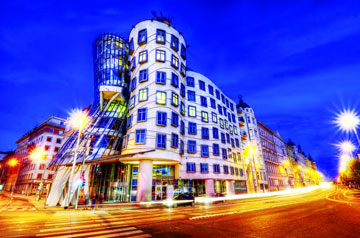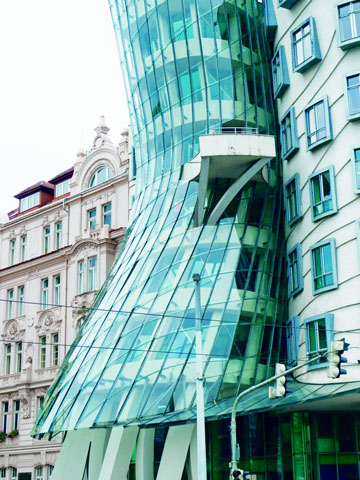Promenade Structure of Czech Republic
|

|
The unusual building design stands out among Baroque, Gothic and Art Nouveau building for Prague is popular. The building was the dream of Vaclav Havel, Czech
president which was hoped to be as a center of cultural activity building in city. |
The dancing housing located in Prague, Czech Republic stands as a mesmerize structure. It was designed by Croatian Czech architect Vlado Milunic in collaboration with Canadian American architect Frank Gehry in 1996.
The house stands on what was formerly a vacant lot created by the American bombing of Prague late in World War Two. The resulting ruins were cleared in 1960 but it was not until the 1980's that serious plans began to be discussed for a building to occupy the space. The dissident Vaclav Havel, who would become the country's president after the 1989 Velvet Revolution, was among those who heard of the plans. Once elected, Havel suggested that the site could be used for a cultural center, an idea which did not succeed.
Architectural Elements
The structure's atypical style, the designers call it as neo-baroque consisted of 99 differently-shaped panels of concrete, topped by Medusa, a twisted metal sculpture. The overall impression was that of two dancers whirling around each other. The location of the Dancing House is a heavily built-up part at the Czech capital city. The building is very different in appearance from the vast majority of its neighbors, which tend to employ art nouveau or traditional baroque architecture. However, in recent years most inhabitants of Prague have accepted the structure as an integral part of their city.
Trifle and Twist
The style is known as 'new-baroque' building to the designer architecture due to its unusual shape. The 'dancing' shape is supported by 99 concrete panels. Each contents a different shape and dimension. On the top of the building is a large twisted structure of metal nicknamed 'Medusa'. The solution has been driven mainly by a kind of aesthetic consideration: the building has two windows, although they have the same height as the two adjacent buildings of the nineteenth century.
It is perceived in the will of the designer, as simple forms on a flat surface but achieve the effect of three-dimensionality, hence the idea of frames as outgoing frames of paintings. The winding moldings on the facade make it more confusing perspective diminishing the contrast with the buildings that surround it. The general shape of the building is featured on a gold 2,000 Czech Koruna coin issued by the Czech National Bank. The coin completes a series called “Ten Centuries of Architecture.
'Ginger and Fred' Dancing on Riverside
VladoMilunic was asked to invite a world-renowned architect for the project. He mentioned the famous Toronto architect and designer Frank O. Gehry. Together they gave a new birth to the built by dynamic look that seems to be dancing on the quay. It represents two dancers Fred Astair and Ginger Rogers so the building is called 'Ginger and Fred'. The glass tower Ginger bends and clings to the concrete tower Fred, which has a metal cupola on the top representing hair. The house is a best example of a deconstructive architecture.
First Interaction by Vlado Milunic
In the interior of a square of buildings in the eighteenth and nineteenth century, the Dancing House has two central bodies. The first is a tower of glass that is close to half height and is supported by curved pillars, the second runs parallel to the river, which is characterized by the moldings that follow a wavy motion and distributed through the windows. Many people ask why the building isn't painted. But Frank Gehry and Vlado Milunic decided that it should use the natural colour of the materials. The glass is green, the concrete is grey, and stainless steel construction is argent. We say the building is so crazy that if we painted it, it would be a problem.
Its striking design caused considerable debate when it was built in the 1990's, but the building has now become sufficiently accepted to be depicted on one of the Czech National Bank's gold coins. When Frank saw the beginning process, sketches, he promised to collaborate with this project. From that time, the first meeting was in 1992 in Geneva, to the finish of the building in 1996 the master mind architects made a nice building with Dutch money. He is known for his perfectness in the architect skills and about Also, this building was the testing point for the Guggenheim Museum. It's controversial for some people not for everybody because the citizens of Prague accept this building.
Partnership with Milunic's Rescue
Nationale-Nederlanden, the Dutch precursor to the present ING Bank, committed itself to sponsorship of a building on the plot in 1991, selecting Milunic to lead the project. The bank asked Milunic to work with another architect of global renown, Jean Nouvel, but he declined the offer as he felt the space allowed was too small. Gehry, however, did agree to become involved and he quickly formed a solid working partnership with Milunic after meeting in 1992.
The bank during those times was one of the most stable and respected companies in the banking sector. This meant that it could do commit to spending almost without limitation on the new project. From the time of that first Geneva meeting onward, the two architects dreamed up a dramatic design that would contain two contrasting elements. These were intended to reflect the country's switch to democracy from communist dictatorship, although during the building's construction, Czechoslovakia had split into the Czech Republic and Slovakia.
Frank Gehry and Vlado Milunic
Frank Gehry Architect contemporary American Architecture Practice based in Los Angeles, California. The architect has won the most prestigious architecture & design awards incl. Pritzker Architecture Prize (1989) American Institute of Architects Gold Medal (1999) and the Royal Institute of British Architects Gold Medal (2000). Milunic was born in Zagreb, Croatia at the time in the Kingdom of Yugoslavia. His family moved out of Yugoslavia when he was 15 and he was educated in Czechoslovakia. Regarding his nationality, he is recorded as saying he is Czechoslovak and feels Yugoslavian, "as a protest against primitive nationalism. A Czech architect was teaching at the Czech Technical University in Prague.He also designed a number of buildings in the Petriny housing estate in Veleslavín, part of Prague 6.
Dancing House behind Czech Republican Coin
The notable design of the structure in 2005 Czech National Bank issued the circulation of last gold coin from 2000 CZK cycle Ten Centuries of Architecture - The Present - House in Prague. The coins are issued in two versions excavation.
 |
Coins in normal and peak performance are minted from 999.9 purity gold. Coin has a weight 6.22 g, diameter 20 mm and thickness 1.55 mm. Similarly, every minting these coins are also deviations in diameter of 0.1 mm and thickness of 0.15 mm. The bottom edge of the coin is the inscription "CZECH REPUBLIC", a two-line inscription above the nominal value of the coin "CZK 2000" and on the left, top and right edge of a copy of 'Ten Centuries of Architecture'. Heraldic animals and texts are placed on a background rhombic network that resembles glass corner tower of the Dancing House and which the animals and font partially overlap. The reverse side of the coin is depicted Dancing House from the ceiling, which is partly intertwined with the letters unclosed inscription 'Present - Dancing House in Prague' as digits year of mintage "2005" at the bottom.
Facts Sheet
- Project: The Dancing Building
- Place: Prague
- Construction: 1992-1996
- Architects: Vlado Milunic and Frank Gehry
- Materials: Steel, glass and precast concert
- Area: 5,400 sqm
- Dome: Metal tubes and covered with a mesh of stainless steel
- Sponsor: Dutch Company
- Republican coin: The general shape of the building featured as a gold coin issued by Czech National Bank. The coin series is known as 'Ten centuries of architecture'
References
http://www.cnb.cz/cs/platidla/numismatika/zlate_mince/deset_stoleti_architektury/zm_tandum.html
http://www.arch2o.com/dancing-house-vlado-milunic-frank-ghery/
http://www.prague.cz/dancing-house/
http://famouswonders.com/dancing-house/